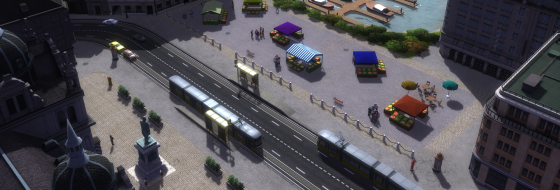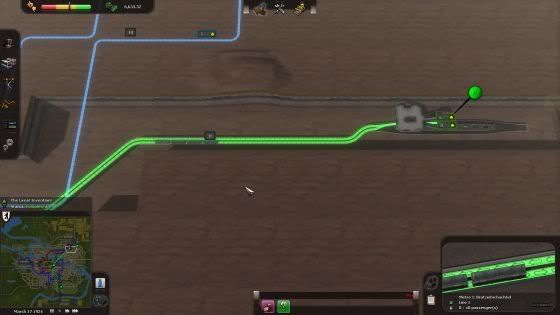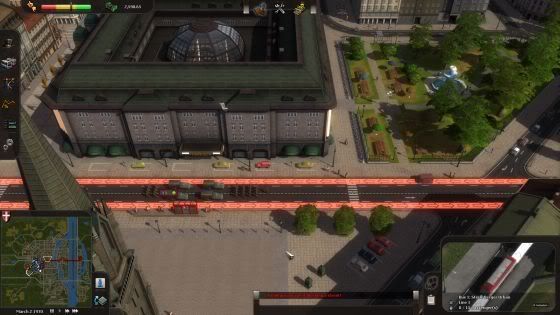
I love a good tycoon game! When I heard that a new studio called Colossal Order was making a Transport Tycoon style strategy game, I was excited, but cautious. I’ve just been burnt way too many times on extremely bad tycoon games in the 90’s. Fortunately, I can now safely say Cities in Motion isn’t one of them. Cities in Motion does tycoon games justice by doing it right. Its got its core gameplay mechanic right without making it over complicated for those that haven’t played a game like this before.
Cities in Motion is a strategy game where you take on the role of a public transportation company and work on building an efficient, and financially profitable mass transit system for your city. It’s not an incredibly complicated game and is quite approachable for new comers. But there is a lot of depth and intricate detail that may not be apparent in the beginning, but you are going to have to pick up on it if you want to build a good transportation network.
It’s A Magical Mystery Bus
Obviously, a game about mass transit systems is going to have vehicles. You don’t have that many options here other than buses, trams, metros and even more imaginative water buses and helicopters(yeah for public transportation). While it may seem a bit lacking in this aspect, you’ll quickly realise that there is a lot of thought required to plan out just these few transportation modes. You’ll have your hands full with just these few. I’m going to guess that Colossal Order might do DLC’s or expansions that add new transportation modes. Anyway I’m getting ahead of myself.
 |
| This isn't good. Imagine living in a city like this |
The most basic mode of transportation are buses. These are probably what you’re going to start with in a game. They are cheap to build stops for and would get you started with some revenue. The problem with buses are that they are susceptible to traffic congestions. If you’ve set up a bus route(which by the way, you don’t manually tell them which road to use, you just place down bus stops and the game calculates the route) in a particular busy street, you could expect your stops to get filled with angry citizens. The buses also contribute to traffic congestion as you’ll notice cars piling up when they stop to pick up customers in bus stops.
Trams are a bit more special. They do of course require tracks and the cool thing about them is that, if you’ve built tracks on a major road/freeway, the trams can use sections of the road not accessible by cars. Allowing trams to bypass some traffic congestion's. They still do get stuck behind traffic and contribute to them in smaller roads and streets though. Due to their faster speed to get past traffic in major roads, these can be used to join your bus networks together which you could then use the buses to go through lesser traffic roads.
 |
| The underground view isn't pretty, but if you want to avoid traffic, going underground is the best choice |
However, nothing moves masses of people faster than the metro. Building a metro will be a major investment for you and they cost a bomb. But their cost will easily be paid by their efficiency of moving lots of people around a city. I tend to use these as the main hub of my transportation network, followed by the trams that carry passengers to smaller routes serviced by buses. This to me, seems like the tidiest and most efficient system I could think of(although I’m pretty sure some savant gamer out there would decipher the most effective and efficient system for all the cities in the game within the first week of the games release).
Water buses and helicopters may not make much sense as public transportation vehicles, but as the developers themselves put it, it is a game after all and they wanted to add something extra that was fun to use. Obviously water buses can be a huge help in a city like Amsterdam, with lots of canals and waterways. You can use them to ferry passengers around the city without any congestion's in the waterways/rivers. Helicopters are attractive to tourists and they have very low capacity and high operating costs.
 |
| Traffic jams are the bane of every public transportation planner! |
Each of these vehicle types have different model types that have different reliability rating, capacity, speed, attractiveness factor(whether passengers like them) and so forth. The different models unlock when you reach a specific year when they become available. It’s not always prudent to upgrade your vehicles when a new model is available. Look at your needs, the length of your transportation lines, how heavy the traffic is on its route and decide based on that.
Kansas City(no... there is no Kansas in Cities in Motion)
Let me get this out of the way first… Cities in Motion has 4 cities in the game. Only 4! There’s Vienna, Helsinki, Berlin, and Amsterdam. When you play the campaign(which is basically 12 scenarios stringed together), you play through these cities during different time periods and they often throw you in situations with specific challenges such as a city hosting the Olympics, or the Berlin wall splitting the city in half etc.
There’s enough variety with these 4 cities to offer a varied experience, but if you’ve been thinking of trying out a new city, you’ll have to dive into the map maker. It’s too bad the game doesn’t have an online custom map browser, but I’m pretty sure the community would be up to the task of building more cities(you'll have to dive into the games forum). Quick, someone make a map of Kuala Lumpur
 |
| Sometimes, roads get disrupted by events like a military parade or a demonstration |
The cities evolve over time. New construction projects pop up, new areas developed, a new Stadium here, or a new airport there. Playing through different time periods would give you a different slice of the city with unique challenges. The cities look nicely rendered, with cars and citizens going about their daily lives. They don’t necessarily look all that different from one city to another(they tend to share the same 3D models for homes, hotels, departmental stores etc although for good reasons; for playability purpose). But you will find some unique landmarks in these cities to make them stand out just a bit from one another.
Cities in Motion really isn’t about the vehicles or the transportation networks you get to set up, it’s about the cities. The key to doing well is to understand how the city is laid out and where the major centres of population are and where they are travelling to. Understand the flow of the people before you plonk down on that bus stop or any other stop for that matter. See where the major roads are and identify traffic heavy routes.
 |
| Use the data view to figure out where different groups live and where they work |
Once you’ve got a good idea of these things, you can start to plan where you want your buses to go to, or where your tram lines will be placed, and where your subways will be and how they will connect to each other to allow passengers to use different modes of transport efficiently and earn you more revenue(make them use multiple transportation vehicles to maximise profit and improve efficiency).
You won’t be able to build an entire mass transit network from the get go as you’ll be financially constrained(by default you start out with $20, 000 which is not much at all). When starting out, you probably won’t be making a huge profit margin and accumulating money is going to be a problem. You can take loans from banks to help you out, but abuse that and you’ll find yourself in the red very quickly with a huge debt to pay off.
You've Got A Ticket To Ride
One of the unique aspect of Cities in Motion is the way it models the people in the cities. They are categorised into seven different social groups. There are blue collar workers, white collar workers, business people, students, tourists, pensioners, and the unemployed. Each of these social groups have unique needs in terms of their destination and how much they are willing to spend to take public transportation(some of them own cars and some groups are unlikely to even own cars).
 |
| You can save the profiles of your citizens so that they show up on the screen at all times. Monitor where they're going. Yeah...It's a little creepy. |
You’ll get requests while playing the campaign or the sand box mode from some characters from one of these groups to fulfill their demands. You can either accept or reject these(it’s a little bewildering why you aren’t shown what the rewards are until you accept a mission). They often give you money for completing them or increasing your reputation with them. Your companies reputation can be influenced by things like how profitable you are, how happy your passengers are and such. With higher reputation the more likely it is for the citizens of the city to use your public transportation. You can commission a marketing campaign to improve your companies reputation. But these only target certain social groups(depending on the media type you choose your advertising campaign on) and are mainly a short term stop gap measure in my opinion.
Baby You’re A Rich Man
Cities in Motion hides lots of numbers under the hood away from you. Placing down stops and creating lines is one thing(this is relatively simple), but ignoring economic realities is never a wise thing to do, in real life or in Cities in Motion. You’ll find that running a profit in the game to be very challenging and you’ll often be operating with a small profit margin(until you build the metro). Which will make your business vulnerable to bad economic conditions.
 |
| The economy matters. Keep an eye on how your city is doing and the price of energy |
When economic growth goes into the negatives, businesses shut down, people lose their jobs. Traffic might decrease and ridership might be affected a little, but you’ll definitely get requests that you fares are too expensive. There’s also the price of petrol and electricity that you have to monitor. If prices go up, cost of operating your company goes up. You’ll probably have to increase your fares to not take a hit on your profits.
Conclusion
Games like these are like puzzle games. You are presented with a situation, you investigate the best course of action, come up with a short term and long term plan and act on it. Then you find out what works well and what didn’t and reiterate until you’ve got the best damn mass transit system. It’s really rare to get a sandbox tycoon/strategy game like this these days. The only remnants of sandbox strategy games that still exists are city builders and some grand strategy games. The satisfaction and joy of the game is in just viewing your masterpiece transportation network, all smooth and with lots of smiley faces from passengers. Not some arbitrarily end game goal.
Which is why I appreciate Cities in Motion quite a bit. It’s doing something that many are not making anymore(a tycoon game). It does have scenarios and a campaign mode which has specific objectives, but personally, I find the mission system in the game not as compelling as the sandbox gameplay it offers. Colossal Order…please make more awesome tycoon games!
Cities in Motion is a good first effort for a new development studio. Its core gameplay is solid and fun if you like games like these. If you enjoy nurturing your company and watching the fruits of your labour blossom into a well greased mass transit network, Cities in Motion manages to deliver a satisfying tycoon game experience. It may start off a little slow and the tutorials don’t make it clear exactly how you go about building a good transportation network(they only give you the basics). But stick with it and you might just find the inner mass transit planner in you.
It’s minor annoyances don’t really ruin the overall experience and hopefully Colossal Order manages to make the game even better with good support for the product. I’m also expecting the community to build more cities than the 4 shipped with the game. The game is single player only with the campaign putting you through 12 scenarios and the sandbox mode allowing you to play any of the four cities from 1920’s all the way up to 2020.
There is a demo that you can try out. If you've had your interest piqued, try it. If you like it buy it. I love to have more games like this in the market.
Pros:
- Easy to learn hard to master. Intricacies of running an efficient line is something you’ll have to figure out yourself.
- It is satisfying to build an efficient mass transit system.
- The scenarios are very challenging. You’ll need to come up with specific strategies to tackle these specific situations. Like the Berlin Wall in Berlin or an economic depression.
- The user interface is generally easy to use once you get used to it. It follows Transport Tycoon closely. Zoom out to get a top down view of your city(this is new obviously since it is a 3D game).
- Economic system has depth. With booms and downturns and as time goes by, the city grows. New buildings and areas are developed.
- Complex citizen model. They have needs and wont just have a single place they go to(leisure, shopping, work, study etc). You can save any one of the citizens profile so you can check on how they are doing in a single easy to access page.
- Charming music.
Cons:
- Lack of hints on what you are doing wrong which might throw off new comers
- Slow paced. Not really a bad point, but I had to put this in here to warn you that it may take a while to get going. You most probably will earn a very small profit margin in the beginning.
- You wont know what the mission rewards are until you accept them
- No thought bubble/text on citizens. Only indicator of happiness is a smiley face. I’ve always loved clicking on tiny people and seeing what they thought in the Chris Sawyer Tycoon games.
- You can’t manually pick your bus routes. They are automatically calculated when you pick a bus stop in your transportation line.
- Data view doesn’t make it that easy to figure out where everyone is living and going to work. You’ll have to use the data view in conjunction with the demographics type to make any sense of it. SimCity 4 Rush Hour did this excellently. You could click on any building and see who travels to it. You can't do this in Cities in Motion. The data view here just not as intuitive as that.
- You can’t upgrade stops to seated stops. You’ll need to demolish it and rebuild your line. Unnecessary busy work.
- Needs more maps.
Verdict: An enjoyable and solid tycoon game. Easy to pick up but hard to master.



Looks like I'll have to buy this one. I love tycoon games as well. Oh, and I appreciated the Ticket to Ride call out.
ReplyDeleteHaha lol. Yeah, I'm really glad to see a game like this. Colossal Order is certainly in my list of developers to keep an eye out for now. But I really do hunger for Asian cities to be added...you know where I'm going with this. I want a Kuala Lumpur :P
ReplyDeleteActually, you *can* upgrade (or downgrade, if you want) stops in place. The UI doesn't make it clear that this is so, but you can just build the new stop right over the old stop and everything will work just as it should.
ReplyDelete